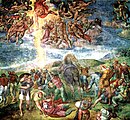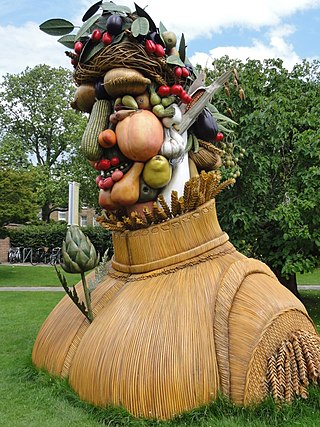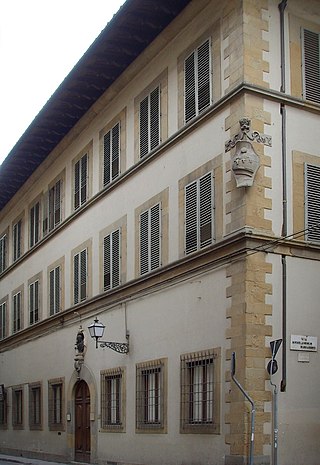The following is a list of works of painting, sculpture and architecture by the Italian Renaissance artist Michelangelo . Lost works are included, but not commissions that Michelangelo never made. Michelangelo also left many drawings, sketches, and some works in poetry.
| Image | Title | Year | Location | Material | Dimensions |
|---|---|---|---|---|---|
 | Christ of Guadalupe | 1560 | Guadalupe, Cáceres, Spain | Ivory | 20 cm |
 | Young Archer (in Italian) | c. 1491–1492 | Metropolitan Museum of Art, New York | Marble | height 97 cm |
 | Venus and Cupid (in Italian) | c. 1491–1492 | Palazzo Medici-Riccardi, Florence | Marble | 43,5x58 cm |
 | Gallino Crucifix (in Italian) | c. 1495–1497 | Bargello Museum, Florence | Wood | 41,3×39,7 cm |
| Young St John the Baptist [5] | c. 1495–1497 | Sacred Chapel of El Salvador, Úbeda | Marble | height 130 cm | |
 | Crucifix of Montserrat (in Spanish) | c. 1497–1498 | Santa Maria de Montserrat Abbey, Monistrol de Montserrat | Ivory | |
 | Naked man I (in Italian) | c. 1501–1504 | Casa Buonarroti, Florence | Terracotta | height 49 cm |
 | Importuno di Michelangelo | c. 1504 | Palazzo Vecchio, Florence | Pietraforte | |
 | Rothschild Bronzes [6] | 1506–1508 | Fitzwilliam Museum | Bronze | |
 | Male torso I (in Italian) | c. 1513 | Casa Buonarroti, Florence | Terracotta | height 23 cm |
 | Male torso II (in Italian) | c. 1513 | Casa Buonarroti, Florence | Terracotta | height 22,5 cm |
 | Naked woman scale model (in Italian) | c. 1513 or 1532 | Casa Buonarroti, Florence | Terracotta | height 35 cm |
 | Cristo della Minerva (first version?) (in Wikimedia) | c. 1514–1516 | San Vincenzo, Bassano Romano | Marble | |
 | Palestrina Pietà [7] | c. 1555 | Galleria dell'Accademia, Florence | Marble | height 253 cm |
 | Scale model for a Crucifix | c. 1562 | Wood | height 20,5 cm | |
| Image | Details | Notes |
|---|---|---|
 |
| |
 |
| |
 (copy by Aristotile da Sangallo) |
|
|
 Detail: The Creation of Adam |
| |
 |
| |
 (copy by Peter Paul Rubens) |
| |
 |
| |
 |
| |
| Image | Details | Notes |
|---|---|---|
 |
| |
 |
| |
| Image | Building | City | Notes |
|---|---|---|---|
 |
| Rome | |
 (model in Casa Buonarroti) |
| Florence | Unexecuted |
 |
| Florence | |
 |
| Florence | |
 |
| Florence | |
 |
| Florence | |
 |
| Rome | |
 |
| Rome | |
 |
| Rome | |
 |
| Rome | |
 |
| Rome | |
 |
| Rome | |
 |
| Rome |
| Image | Details | Notes |
|---|---|---|
 |
| |
 |
| |
 |
| |
 |
| |
 |
| |
 |
|
![]() Media related to Michelangelo Buonarroti catalogue raisonné, 2007 at Wikimedia Commons
Media related to Michelangelo Buonarroti catalogue raisonné, 2007 at Wikimedia Commons

Michelangelo di Lodovico Buonarroti Simoni, known mononymously as Michelangelo, was an Italian sculptor, painter, architect, and poet of the High Renaissance. Born in the Republic of Florence, his work was inspired by models from classical antiquity and had a lasting influence on Western art. Michelangelo's creative abilities and mastery in a range of artistic arenas define him as an archetypal Renaissance man, along with his rival and elder contemporary, Leonardo da Vinci. Given the sheer volume of surviving correspondence, sketches, and reminiscences, Michelangelo is one of the best-documented artists of the 16th century. He was lauded by contemporary biographers as the most accomplished artist of his era.

The Sistine Chapel is a chapel in the Apostolic Palace, the pope's official residence in Vatican City. Originally known as the Cappella Magna, the chapel takes its name from Pope Sixtus IV, who had it built between 1473 and 1481. Since that time, the chapel has served as a place of both religious and functionary papal activity. Today, it is the site of the papal conclave, the process by which a new pope is selected. The fame of the Sistine Chapel lies mainly in the frescoes that decorate the interior, most particularly the Sistine Chapel ceiling and The Last Judgment, both by Michelangelo.

The Ashmolean Museum of Art and Archaeology on Beaumont Street, Oxford, England, is Britain's first public museum. Its first building was erected in 1678–1683 to house the cabinet of curiosities that Elias Ashmole gave to the University of Oxford in 1677. It is also the world's second university museum, after the establishment of the Kunstmuseum Basel in 1661 by the University of Basel.

The Pietà is a subject in Christian art depicting the Blessed Virgin Mary cradling the mortal body of Jesus Christ after his Descent from the Cross. It is most often found in sculpture. The Pietà is a specific form of the Lamentation of Christ in which Jesus is mourned by sole privilege of the Virgin Mary alone, while representing her "sixth sorrow" and sometimes accompanied by a specific Marian title.

The Fitzwilliam Museum is the art and antiquities museum of the University of Cambridge. It is located on Trumpington Street opposite Fitzwilliam Street in central Cambridge. It was founded in 1816 under the will of Richard FitzWilliam, 7th Viscount FitzWilliam (1745–1816), and comprises one of the best collections of antiquities and modern art in western Europe. With over half a million objects and artworks in its collections, the displays in the museum explore world history and art from antiquity to the present. The treasures of the museum include artworks by Monet, Picasso, Rubens, Vincent van Gogh, Rembrandt, Cézanne, Van Dyck, and Canaletto, as well as a winged bas-relief from Nimrud. Admission to the public is always free.

The Isabella Stewart Gardner Museum is an art museum in Boston, Massachusetts, which houses significant examples of European, Asian, and American art. Its collection includes paintings, sculpture, tapestries, and decorative arts. It was founded by Isabella Stewart Gardner, whose will called for her art collection to be permanently exhibited "for the education and enjoyment of the public forever."

The Creation of Adam, also known as The Creation of Man, is a fresco painting by Italian artist Michelangelo, which forms part of the Sistine Chapel's ceiling, painted c. 1508–1512. It illustrates the Biblical creation narrative from the Book of Genesis in which God gives life to Adam, the first man. The fresco is part of a complex iconographic scheme and is chronologically the fourth in the series of panels depicting episodes from Genesis.

The Thinker is a bronze sculpture by Auguste Rodin, situated atop a stone pedestal. The work depicts a nude male figure of heroic size sitting on a rock. He is seen leaning over, his right elbow placed on his left thigh, holding the weight of his chin on the back of his right hand. The pose is one of deep thought and contemplation, and the statue is often used as an image to represent philosophy.

The Cardsharps is a painting by the Italian Baroque artist Michelangelo Merisi da Caravaggio. The original is generally agreed to be the work acquired by the Kimbell Art Museum in 1987, although Caravaggio may have painted more than one version.
Leo Steinberg was an American art critic and art historian.

John Thomas Spike is an American art historian, curator, and author, specializing in the Italian Renaissance and Baroque periods. He is also a contemporary art critic and past director of the Florence Biennale.

Philip Haas is an American artist, screenwriter and filmmaker, perhaps best known for his 2012 sculpture exhibition "The Four Seasons" and his 1995 film Angels and Insects.

Casa Buonarroti is a museum in Florence, Italy that is situated on property owned by the sculptor Michelangelo that he left to his nephew, Leonardo Buonarroti. The complex of buildings was converted into a museum dedicated to the artist by his great nephew, Michelangelo Buonarroti the Younger. Its collections include two of Michelangelo's earliest marble sculptures, the Madonna of the Stairs and the Battle of the Centaurs. A ten-thousand book library includes the family archive and some of Michelangelo's letters and drawings. The Galleria is decorated with paintings commissioned by Buonarroti the Younger and was created by Artemisia Gentileschi and other early seventeenth-century Italian artists.

The Torment of Saint Anthony is attributed to Michelangelo, who painted a close copy of the famous engraving by Martin Schongauer when he was only 12 or 13 years old. Whether the painting is actually by Michelangelo is disputed. This painting is now in the Kimbell Art Museum in Fort Worth, Texas. It shows the common medieval subject, included in the Golden Legend and other sources, of Saint Anthony being assailed in the desert by demons, whose temptations he resisted; the Temptation of St Anthony is the more common name of the subject. But this composition apparently shows a later episode where St Anthony, normally flown about the desert supported by angels, was ambushed in mid-air by devils.
David Franklin is an art historian with expertise in Italian Renaissance art, a curator, and a former art museum director.
Alessandro Vezzosi is an Italian art critic, Leonardo scholar, artist, expert on interdisciplinary studies and creative museology, he is also the author of hundreds of exhibits, publications and conferences, in Italy and abroad on Leonardo da Vinci and the Renaissance, contemporary art and design. Amongst others, he was the first scholar from the Armand Hammer Centre for Leonardo Studies from the University of California in Los Angeles (1981), directed by Carlo Pedretti; he taught at the University of Progetto in Reggio Emilia; and he is honorary professor at the Accademia delle Arti del Disegno of Florence. He began as an artist from 1964 to 1971 winning more than 80 prizes in painting competitions. In the Seventies he was the founder of the "Archivio Leonardisimi" and of Strumenti-Memoria del Territorio; he coordinated "ArteCronaca", he was the historical-artistic consultant of the Municipality of Vinci and he collaborated on the publications on Tuscany and Leonardo, modern and contemporary art. In 1980 he curated the Centro di Documentazione Arti Visive of the Municipality of Florence.

The Temptation of St. Anthony is an engraving, probably created c. 1470–75, by Martin Schongauer of this popular scene in 15th-century art. In it, grotesque demons swarm around Saint Anthony the Great, bursting with movement and energy as the saint calmly resists their temptations or blows. St. Anthony is shown with some of his signature attributes, dressed in a monk's religious habit and cowl, carrying a staff with a tau-shaped handle and his bound girdle book hanging from his belt. The literary source from which this image derives is debated. The image could depict chapter 65 from Athanasius's Life of St. Anthony, where the hermit has a vision of himself floating through the air and undefined beings prevent him from ascending back to reality or it could show the ninth chapter of Athanasius's Life of St. Anthony, where St. Anthony is attacked by the devil in the form of animals and beasts in the Egyptian desert and is levitated in the air by his practice of rigorous asceticism.

The Rothschild Bronzes, also known as the Michelangelo Bronzes, are a pair of 16th century statuettes, each depicting a nude male figure riding a mythological animal, usually identified as a panther. Mirroring each other in pose, the nude men are distinguished by age, one young, the other bearded. The younger man is 76.6 cm, the other almost 90 cm high. The sculptures are unsigned and the figures and panthers have been separately cast. The bronzes were displayed to the public at the Fitzwilliam Museum, University of Cambridge, from February to August 2015 with an attribution to Michelangelo. If the attribution is correct, Michelangelo would have made the bronzes around 1506 to 1508, before the painting of the Sistine Chapel ceiling but after the marble statue of David. The sculptures would be the only autograph bronze works by Michelangelo to have survived.